Basketball is a game of speed, agility, and precision. For players who use prosthetics, the challenge isn’t just about mastering the sport—it’s about ensuring their prosthetic works seamlessly with their movements. The right basketball prosthetic can make all the difference, providing stability, balance, and control while allowing players to dribble, pivot, and shoot with confidence.
Technology has made it possible for athletes with limb differences to compete at high levels, from recreational games to professional leagues. But playing at your best requires more than just a prosthetic—it demands the right fit, training, and mindset. Whether you’re just starting or looking to refine your skills, understanding how to choose and use the best prosthetic for basketball is key.
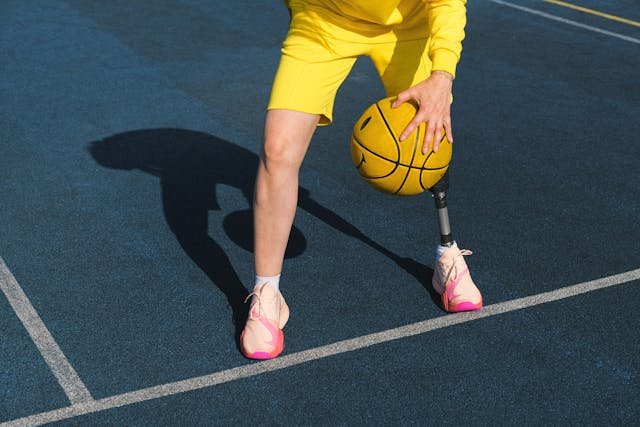
Choosing the Right Basketball Prosthetic
The right prosthetic can transform how you play basketball. Unlike everyday prosthetics, which prioritize comfort and stability for walking, a sports-specific prosthetic is designed to handle quick movements, sudden stops, and jumps.
It needs to be lightweight, responsive, and durable, allowing for seamless motion on the court.
For lower-limb amputees, a basketball prosthetic should provide excellent shock absorption and energy return. Carbon fiber running blades or high-performance prosthetic feet offer the flexibility and bounce needed for sprinting and jumping.
The suspension system must ensure a snug fit to prevent movement inside the socket, reducing the risk of injury and improving control.
Above-knee amputees may require a specialized prosthetic knee that responds quickly to rapid changes in movement. Microprocessor-controlled knees adjust resistance in real time, helping players maintain balance when shifting directions or landing from a jump.
Some mechanical knees offer spring-loaded assistance, allowing for smoother transitions between running, stopping, and jumping.
For upper-limb amputees, a basketball prosthetic should offer a secure grip and flexibility.
Some players prefer mechanical prosthetic arms with locking elbow joints for better shooting stability, while others opt for myoelectric hands that provide a natural range of motion for dribbling and passing.
The key is finding a prosthetic that complements your playing style and movement needs.
At Robobionics, we specialize in advanced prosthetic solutions tailored for sports. Our Grippy™ bionic hand offers precise grip control, making it an excellent choice for basketball players who need flexibility and strength in their upper limb prosthetic.
If you’re looking for the best fit for your game, book a free demo and experience the difference firsthand.
The Importance of Proper Fit and Alignment
A well-fitted prosthetic can be the difference between smooth movement and discomfort. Basketball requires quick cuts, rapid accelerations, and sudden stops—any instability in the prosthetic can throw off balance and make it harder to perform at your best.
Socket fit is one of the most important factors in ensuring stability. If the socket is too loose, the prosthetic may shift, leading to loss of control. If it’s too tight, it can cause discomfort and restrict motion.
Working with a prosthetist to fine-tune the fit ensures that your prosthetic remains secure without causing irritation.
Alignment also plays a major role in comfort and efficiency. A prosthetic that is too far forward or backward can lead to uneven weight distribution, making movements feel unnatural.
Adjusting alignment based on your playing style can improve mobility and reduce strain on your residual limb.
Players should also pay attention to suspension systems. A vacuum suspension or pin-lock system ensures that the prosthetic stays firmly in place during high-impact movements.
Sweat management is another factor—since basketball is a fast-paced sport, using moisture-wicking liners can help prevent slippage and discomfort.
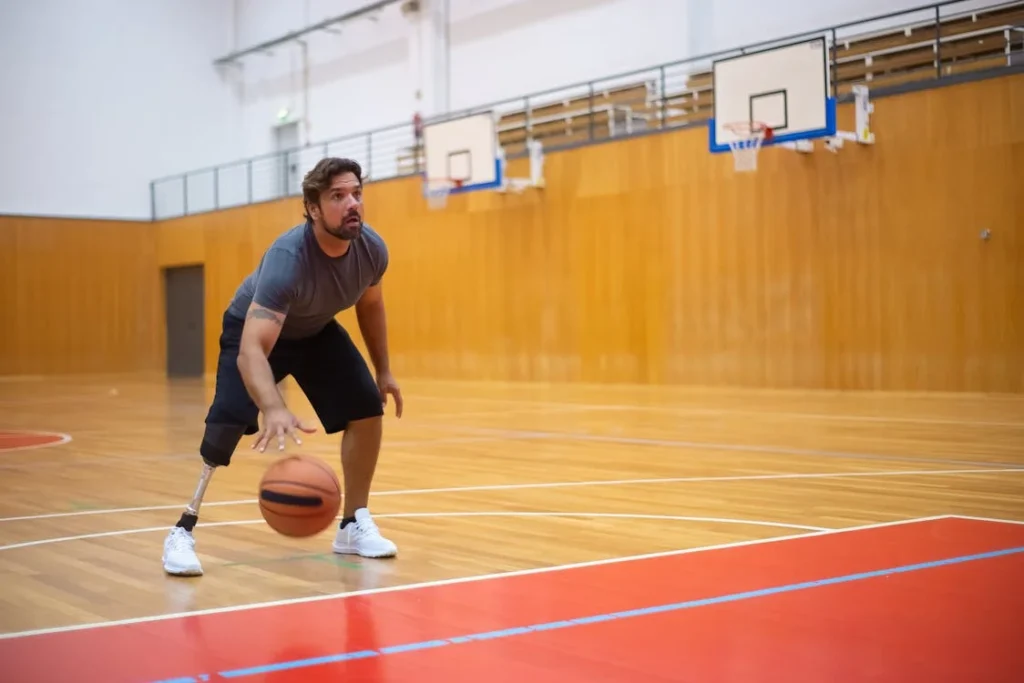
Mastering Movement with a Basketball Prosthetic
Once you have the right prosthetic, the next step is learning how to move efficiently on the court. Basketball is a game of rapid changes in direction, sudden stops, and explosive jumps.
Adapting to these movements with a prosthetic takes practice, but with the right techniques, you can play at a high level with confidence.
Building Balance and Stability
Balance is the foundation of every movement in basketball. Whether you’re dribbling, defending, or preparing for a jump shot, maintaining stability allows you to move with control.
For lower-limb amputees, core strength is essential. Since the prosthetic may distribute weight differently than a biological limb, developing strong core muscles helps maintain stability, especially during quick turns and pivots.
Practicing weight shifts can improve balance. Standing on one leg while engaging your core helps strengthen stability. Gradually adding movement, such as shifting weight from side to side or holding a defensive stance, prepares you for real-game situations.
For upper-limb amputees, balance is about controlling movement while dribbling, passing, or shooting. A well-fitted prosthetic ensures that weight distribution remains even, preventing unnecessary strain on the shoulders or back.
Adjusting to the feel of a prosthetic when holding a basketball takes time, but practicing dribbling and grip control can help develop muscle memory.
Improving Speed and Agility
Basketball is a fast-paced sport that requires quick reactions. Lower-limb prosthetics should allow for smooth acceleration and deceleration, making it easier to sprint down the court and stop abruptly without losing balance.
A prosthetic foot or blade with good energy return helps propel movement, reducing fatigue and improving overall speed.
Practicing agility drills can enhance quickness. Cone drills, lateral shuffles, and sprint-to-stop exercises train the body to react quickly to changes in direction.
For players using prosthetic knees, adjusting stride patterns and focusing on controlled stops can help improve movement efficiency.
For upper-limb prosthetic users, agility is about hand speed and coordination. Fast, controlled dribbling helps develop better ball-handling skills.
Practicing crossovers, behind-the-back dribbles, and one-handed control strengthens reflexes and grip, making it easier to move fluidly on the court.
Jumping and Landing with a Prosthetic
Jumping is a crucial skill in basketball, whether for shooting, rebounding, or blocking. Lower-limb prosthetic users must focus on explosive power while maintaining control.
A running blade or specialized sports foot can provide the energy return needed for jumping, but technique is equally important.
When jumping, pushing off with the stronger leg while engaging the prosthetic helps generate more height. Landings should be controlled, with knees slightly bent to absorb impact.
Practicing jump training, such as box jumps and rebounding drills, helps strengthen leg muscles and improve overall jumping ability.
For upper-limb prosthetic users, shooting technique is key. A well-balanced prosthetic arm allows for smoother follow-through and better control.
Practicing shooting form, focusing on wrist movement and release, ensures consistency in shots. Players using a mechanical or bionic hand can adjust grip pressure to find the best way to hold and release the ball comfortably.

Developing Game Skills with a Prosthetic
Once you’ve built a solid foundation in movement, balance, and agility, the next step is refining your basketball skills.
Shooting, dribbling, passing, and defense all require adjustments when using a prosthetic, but with practice, you can develop techniques that suit your playing style.
Shooting with Precision
Shooting is all about rhythm, balance, and follow-through. For lower-limb prosthetic users, maintaining a stable stance is essential.
Since the prosthetic may distribute weight differently, players must find a comfortable shooting position that allows for a smooth, controlled release. A slightly wider stance can help with balance, especially when taking jump shots.
Jump shots require explosive power and coordination. Practicing shot mechanics, focusing on foot placement and arm movement, helps create consistency. Using video feedback or working with a coach can help identify any balance shifts that might affect accuracy.
For upper-limb prosthetic users, shooting requires adapting grip and release techniques. A mechanical prosthetic hand should allow for controlled wrist motion, while myoelectric or bionic hands can be adjusted for grip sensitivity.
Practicing one-handed shooting or modifying the follow-through technique can improve accuracy over time.
Dribbling and Ball Control
Dribbling with a prosthetic presents unique challenges, but with practice, it can become second nature. Lower-limb amputees must ensure that their movements stay fluid while dribbling, focusing on keeping the ball low and close to the body.
Since sudden stops and direction changes are common in basketball, practicing control in motion helps improve overall ball-handling skills.
For upper-limb prosthetic users, dribbling relies on wrist flexibility and grip control. A prosthetic with a rotating wrist or responsive fingers can enhance dribbling efficiency.
Practicing dribble moves such as crossovers, spin moves, and behind-the-back dribbles helps develop hand speed and coordination.
Passing with Accuracy
Passing is a critical skill that relies on strength and precision. Lower-limb amputees should focus on maintaining a balanced stance while passing to ensure better control.
A strong core helps generate power in passes, whether making a quick bounce pass or a long outlet pass down the court.
Upper-limb prosthetic users can develop passing skills by adjusting their grip and release mechanics. A bionic hand with adjustable tension allows for better ball control, while a mechanical prosthetic arm with a locking elbow can provide stability for chest and overhead passes.
Practicing different passing techniques, including one-handed and off-hand passes, helps improve versatility on the court.
Defensive Strategies and Positioning
Defense requires quick reactions, lateral movement, and anticipation. Lower-limb amputees must focus on foot positioning, ensuring that weight distribution allows for fast shifts in direction.
A strong defensive stance—knees slightly bent, body centered—helps maintain control while guarding opponents.
For upper-limb prosthetic users, defensive techniques like deflecting passes, contesting shots, and blocking require precise hand positioning.
A prosthetic arm with a firm yet flexible grip can help with ball control during steals and defensive rebounds. Practicing defensive drills, such as shadowing an opponent or reacting to directional changes, sharpens reflexes and improves reaction time.
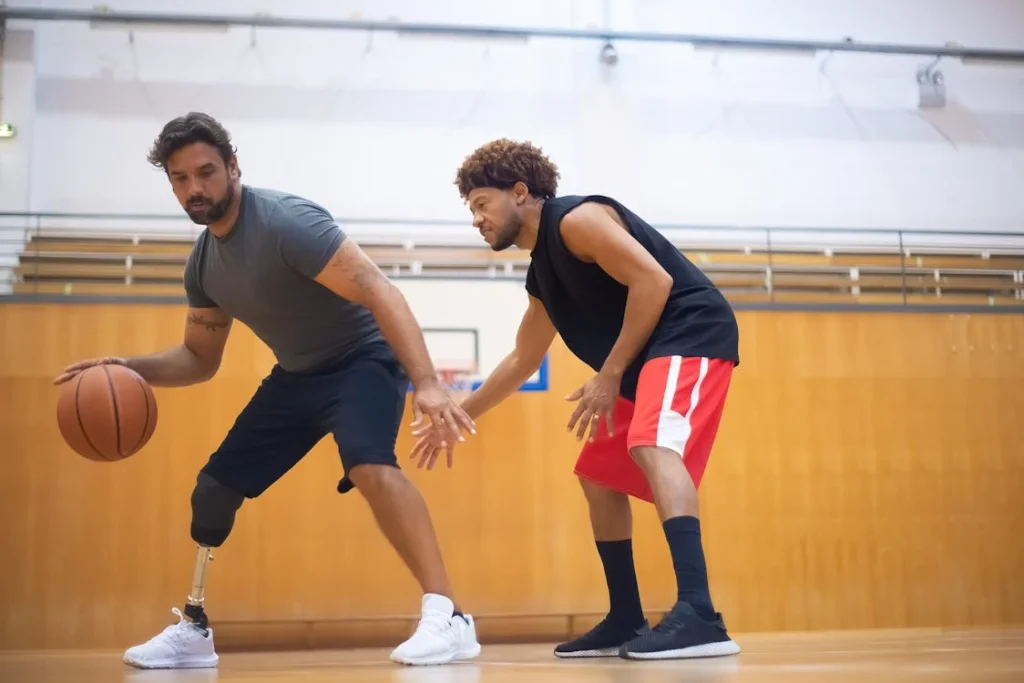
Building Confidence on the Court
Playing basketball with a prosthetic isn’t just about physical ability—it’s also about confidence. A strong mindset, combined with the right training and preparation, allows players to compete at their best without hesitation.
Overcoming challenges and believing in your ability to perform can transform the way you play the game.
Mental Preparation and Game Readiness
Confidence begins with preparation. The more comfortable you are with your prosthetic, the more naturally you’ll move on the court.
Practicing fundamental skills daily—shooting, dribbling, passing, and footwork—builds muscle memory, making movements feel automatic during games.
Visualization is another powerful tool. Many elite athletes use mental imagery to prepare for games, picturing themselves making successful plays, hitting key shots, and executing strong defensive moves.
Visualizing success helps reinforce positive thinking, reducing anxiety and improving focus during competition.
Overcoming Challenges and Adjusting to the Game
Every athlete faces setbacks, and adapting to basketball with a prosthetic is no different. Early on, there may be frustrations—missed shots, difficulty dribbling, or struggling with speed and agility. The key is persistence. Small improvements each day lead to long-term progress.
Experimenting with different techniques helps refine your playstyle. Adjusting shooting form, modifying dribble techniques, or working on defensive positioning allows players to find what works best for them.
Seeking feedback from coaches, teammates, or other athletes with prosthetics can provide valuable insights.
Gaining Trust in Your Prosthetic
Confidence comes from trust—trusting your body, your skills, and your prosthetic. A well-fitted prosthetic that feels secure allows you to play freely, without worrying about instability or discomfort.
Regular adjustments, check-ups with a prosthetist, and maintaining your equipment ensure that your prosthetic is always in peak condition.
Learning how to react instinctively with your prosthetic takes time. Once movements become second nature, you’ll stop thinking about the mechanics and start focusing entirely on the game.
The more you trust your prosthetic, the more you can push your limits, taking on faster opponents, attempting more challenging shots, and improving overall performance.
Finding Community and Support
Surrounding yourself with a supportive community can be a game-changer. Adaptive sports organizations, wheelchair basketball leagues, and prosthetic user groups provide opportunities to connect with others who share similar experiences.
Learning from other athletes who have successfully adapted to playing basketball with a prosthetic can be inspiring and motivating.
Coaches and teammates also play a vital role in building confidence. Playing in a supportive team environment fosters growth, helping you develop skills while enjoying the game.
Many professional and collegiate teams now include adaptive athletes, proving that with the right mindset and training, high-level competition is possible.
At Robobionics, we are dedicated to helping athletes play with confidence by providing advanced prosthetic solutions.
Whether you need a customized prosthetic arm for better ball control or a high-performance leg for improved mobility, we are here to support your journey. Book a consultation today and take your game to the next level.
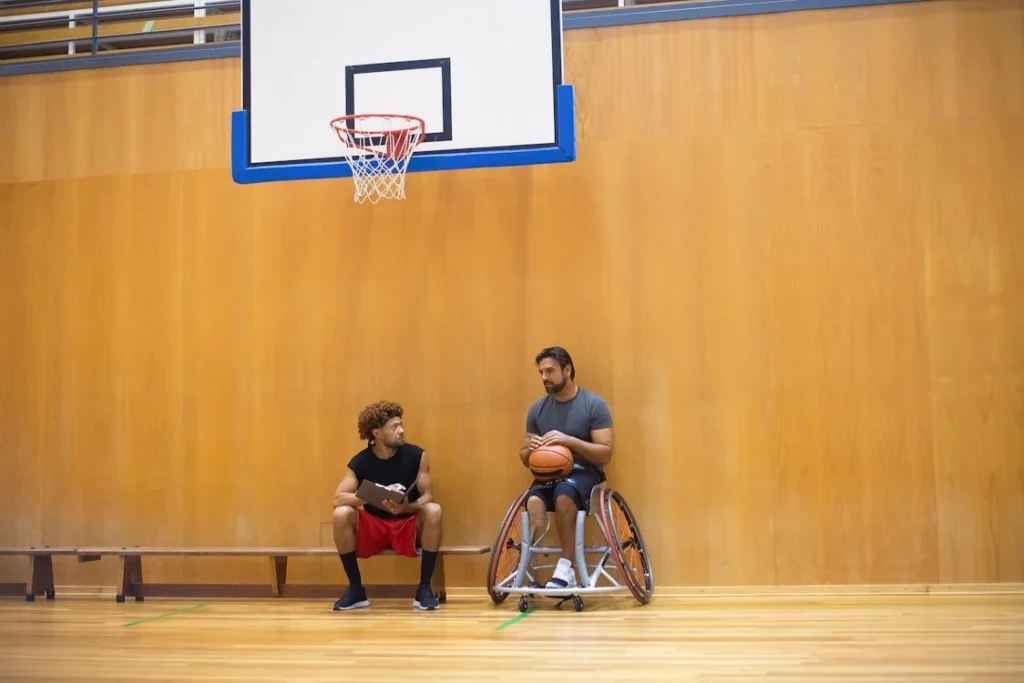
Adapting to Different Playing Environments
Basketball is played in a variety of settings, from indoor courts with polished hardwood to outdoor playgrounds with concrete or asphalt surfaces.
Each environment presents unique challenges, and adapting your playing style and prosthetic use accordingly can make a big difference in performance and comfort.
Playing on Indoor Courts
Indoor basketball courts provide a smooth, predictable surface, making movement more controlled and stable. For players using lower-limb prosthetics, the consistency of hardwood floors allows for better traction and smoother transitions between running, stopping, and pivoting.
However, indoor courts can also be slippery, especially when sweat or dust accumulates on the surface. Prosthetic users should ensure that their footwear—whether part of a foot shell or a shoe worn on a sound limb—offers good grip.
Some athletes may need to adjust their gait or balance slightly to compensate for the reduced traction.
For upper-limb prosthetic users, indoor play allows for better control over passing and shooting. The consistent bounce of the basketball on hardwood makes dribbling easier, but players should still practice adjusting grip and ball-handling techniques to maximize efficiency.
Adapting to Outdoor Courts
Outdoor courts introduce different variables, such as uneven surfaces, cracks, and changing weather conditions. Asphalt or concrete courts are rougher on prosthetic components and can impact movement, especially for players who rely on speed and agility.
Lower-limb prosthetic users may need to be more cautious with quick stops and changes in direction, as the harder surface provides less shock absorption than indoor floors.
Some players choose prosthetic feet with additional cushioning or slight flex to handle the increased impact.
Weather also plays a role in outdoor play. Heat can cause sweat buildup inside a prosthetic socket, leading to discomfort.
Moisture-wicking liners and breathable materials can help manage sweat and improve grip inside the socket. Rain or damp conditions can make outdoor courts slippery, so ensuring good traction is essential.
For upper-limb prosthetic users, wind and environmental factors can slightly alter passing and shooting accuracy. Practicing in different conditions helps players adapt and improve ball control regardless of the setting.
Transitioning Between Different Surfaces
Many basketball players switch between indoor and outdoor play, requiring adjustments in movement and prosthetic performance. Practicing on both surfaces helps athletes develop adaptability, ensuring they can perform at their best regardless of the environment.
Lower-limb prosthetic users can experiment with different stride lengths and movement patterns to see what works best for each surface. Upper-limb users can work on grip adjustments and ball-handling techniques to maintain control in various playing conditions.
Regular maintenance of the prosthetic is also important when playing on different surfaces. Outdoor play can cause more wear and tear on prosthetic components, so cleaning and checking for any signs of damage ensures longevity and consistent performance.
At Robobionics, we design prosthetics that adapt to various playing conditions, helping athletes stay competitive no matter where they play. If you need a customized solution for both indoor and outdoor basketball, schedule a consultation with us today.
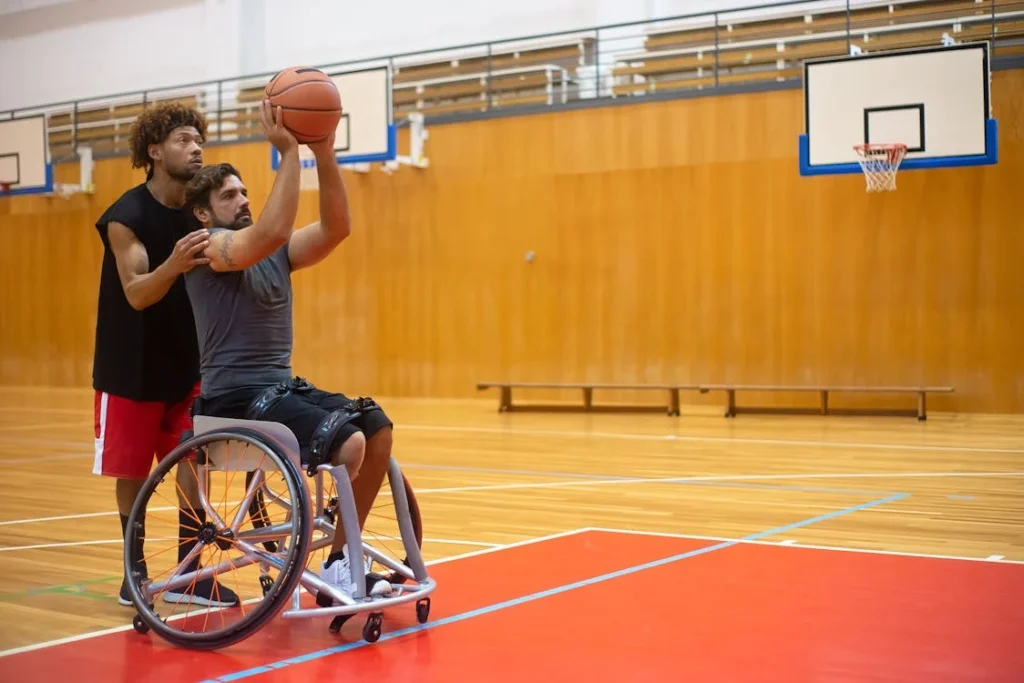
Preventing Injuries and Ensuring Long-Term Performance
Playing basketball with a prosthetic can be physically demanding, and injury prevention is essential for maintaining long-term performance. While prosthetics provide the mobility and flexibility needed for the game, they also introduce unique stresses on the body.
Taking the right precautions can help minimize the risk of discomfort, strain, and injuries, allowing you to play safely and confidently.
Understanding Common Injuries
Athletes who use prosthetics are prone to specific types of injuries, often caused by overuse, improper fit, or excessive strain on the residual limb.
Skin irritation, blisters, and pressure sores can develop if the prosthetic socket doesn’t fit properly or if there’s too much friction during movement.
Joint pain in the knee, hip, or back may occur if the prosthetic alignment isn’t optimized, forcing the body to compensate for imbalances.
Lower-limb prosthetic users may also experience muscle fatigue due to the added effort required for explosive movements, such as sprinting and jumping.
The repetitive impact of running up and down the court can place stress on the residual limb, leading to soreness if proper rest and recovery aren’t prioritized.
Upper-limb prosthetic users may encounter strain in the shoulder and upper back, particularly if the prosthetic weight distribution isn’t adjusted correctly. Improper shooting mechanics can also lead to repetitive stress injuries, affecting long-term performance.
Maintaining Proper Prosthetic Fit
One of the best ways to prevent injuries is to ensure that the prosthetic fits properly at all times. A socket that is too loose can lead to instability, while one that is too tight can restrict circulation and cause pain.
Regular adjustments, especially as your body adapts to training and competition, help maintain a secure and comfortable fit.
Sweat buildup can also cause irritation, particularly in high-intensity sports like basketball. Moisture-wicking liners and breathable materials can help keep the residual limb dry, reducing the risk of skin issues.
Checking the skin regularly for redness or soreness allows players to address potential problems before they become serious injuries.
Strength and Conditioning for Injury Prevention
Building strength in key muscle groups can help prevent injuries and improve overall performance. Lower-limb prosthetic users should focus on strengthening the hip, glute, and core muscles to maintain balance and reduce strain on the residual limb.
Exercises like squats, lunges, and single-leg stability drills help develop the strength needed for quick movements and jumps.
For upper-limb prosthetic users, shoulder and upper body conditioning is essential. Resistance training, such as rows, presses, and rotational exercises, helps prevent overuse injuries and ensures better control when passing or shooting.
Maintaining flexibility through stretching and mobility drills also reduces tension and enhances range of motion.
Prioritizing Rest and Recovery
Recovery is just as important as training. Pushing too hard without proper rest can lead to overuse injuries, reducing performance over time. Cooling down after games, stretching, and using ice or compression techniques can help prevent muscle soreness and inflammation.
Getting enough rest between games allows the body to recover and adapt to the physical demands of basketball.
Regular check-ups with a prosthetist ensure that the prosthetic continues to perform at its best, preventing any discomfort or misalignment from interfering with movement.
At Robobionics, we prioritize long-term comfort and performance by offering expert consultations and prosthetic adjustments tailored to athletes.
If you want to maximize your performance while preventing injuries, reach out to us for personalized guidance on the best prosthetic solutions for your needs.

Competing at a High Level: Taking Your Game to the Next Stage
For athletes who are serious about basketball, playing with a prosthetic should not be a limitation—it should be a challenge to push past and overcome.
With the right training, mindset, and prosthetic technology, players can compete at recreational, amateur, and even professional levels. The key is refining skills, improving endurance, and adapting to high-level competition.
Training Like an Elite Athlete
High-level basketball requires more than just skill; it demands endurance, agility, and
mental toughness. Athletes using prosthetics must develop specialized training routines that focus on their specific movement patterns. This means incorporating exercises that enhance speed, improve reaction time, and build the strength needed for sustained performance.
For lower-limb prosthetic users, explosive drills such as sprinting intervals, agility ladder drills, and jump training help develop the power and quickness necessary for competitive play.
Practicing sudden stops, pivots, and defensive movements ensures that the prosthetic responds naturally to rapid changes in direction.
Upper-limb prosthetic users can improve passing, shooting, and dribbling through high-repetition drills.
Shooting under game-like conditions, practicing ball-handling against defenders, and working on quick-release passes help develop confidence and efficiency under pressure. Strength training is also crucial to maintaining endurance throughout long games.
Competing in Adaptive and Mainstream Leagues
Many athletes with prosthetics compete in adaptive basketball leagues, such as wheelchair basketball, which follows the same fundamental rules as traditional basketball but allows for modified movement styles.
These leagues offer structured competition and provide a platform for players to develop their skills and compete at regional, national, and even international levels.
For those who wish to compete in mainstream leagues, adapting playstyle to fit the dynamics of a fast-paced game is crucial.
Players must be comfortable using their prosthetic in high-contact situations, maintaining control even when faced with physical challenges from opponents. Competitive leagues also require endurance, so training to sustain high performance for extended periods is essential.
Developing a Winning Mindset
Success in basketball isn’t just about physical ability—it’s about mental toughness. Players with prosthetics often face challenges that able-bodied athletes do not, from adapting to new movements to overcoming doubts about their abilities.
Developing a strong mindset helps athletes stay focused, push through setbacks, and perform at their best.
Visualization techniques help players mentally prepare for games. Seeing yourself making successful plays, scoring key baskets, and defending effectively builds confidence and reinforces positive habits.
Watching professional athletes with prosthetics can also serve as motivation, proving that high-level competition is possible with the right training and commitment.
Seeking Coaching and Mentorship
Having the right guidance can accelerate development. Working with coaches who understand the needs of adaptive athletes provides valuable feedback and helps fine-tune techniques.
Finding mentors—athletes who have successfully competed with prosthetics—can also provide inspiration and practical advice on navigating challenges.
Many elite athletes with prosthetics have used specialized coaching programs to refine their skills, adapt their techniques, and compete against top competition.
Whether through personal coaching, team training, or sports science programs, investing in the right guidance can elevate performance.
Pushing the Boundaries of What’s Possible
Basketball is evolving, and athletes with prosthetics are proving that physical differences don’t limit skill or ability.
The growth of adaptive sports, advancements in prosthetic technology, and increasing acceptance of inclusive competition mean that more opportunities exist than ever before.
Whether you’re playing for fun, competing in leagues, or striving for professional-level performance, the possibilities are limitless.
At Robobionics, we support athletes in reaching their full potential. Our cutting-edge prosthetic solutions are designed for high-performance sports, ensuring that players get the best fit, comfort, and control needed to compete at any level.
If you’re ready to take your game further, book a consultation with us and explore how the right prosthetic can transform your basketball experience.
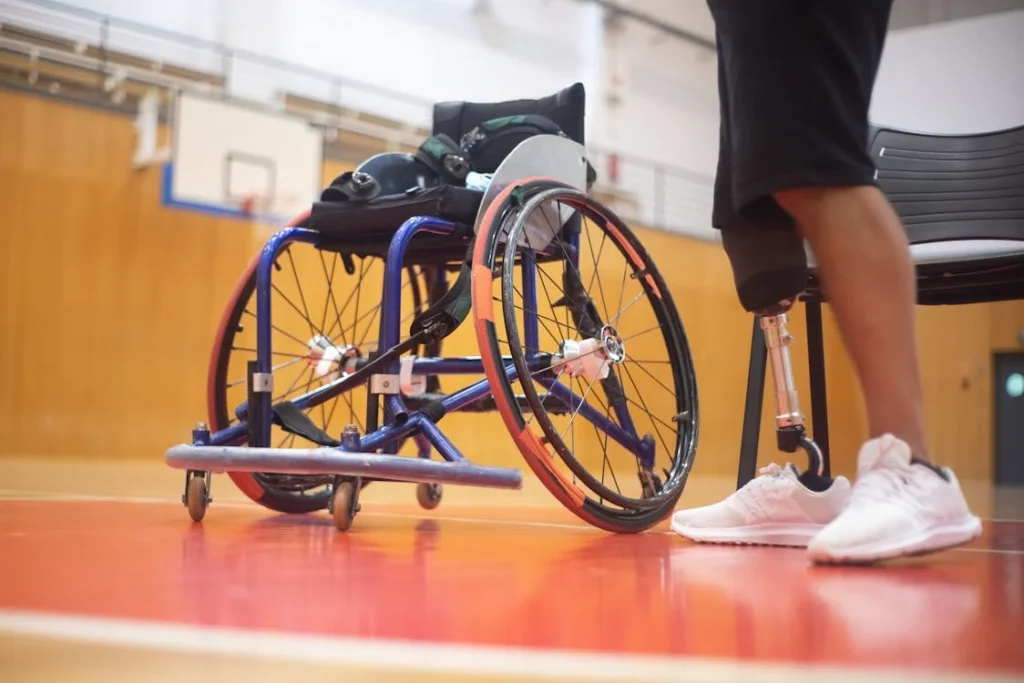
The Future of Basketball Prosthetics: Innovations and Advancements
As technology continues to advance, the future of basketball prosthetics is becoming more exciting than ever. New developments in prosthetic design, materials, and biomechanics are helping athletes move more naturally, enhance performance, and reduce fatigue.
With research and innovation pushing boundaries, the next generation of prosthetics will further bridge the gap between adaptive and able-bodied athletes.
Smart Prosthetics and AI Integration
One of the most promising advancements in sports prosthetics is the integration of artificial intelligence (AI) and smart sensors.
These technologies allow prosthetics to adapt to movement patterns in real time, providing smoother and more natural responses to different actions on the court.
For lower-limb amputees, AI-driven knees and ankles are becoming more advanced. These smart joints can detect a player’s speed, angle of movement, and level of force applied, adjusting resistance and flexibility accordingly.
This means that a basketball player using a prosthetic knee can experience better control when stopping suddenly, jumping, or sprinting down the court.
Upper-limb prosthetic users are also seeing innovations in sensor-driven grip control. Some advanced prosthetic hands can now recognize the shape and texture of an object—like a basketball—and adjust grip strength automatically.
This makes dribbling, catching, and passing more intuitive, giving players a more natural feel of the ball.
Advanced Materials for Enhanced Performance
Lightweight, high-durability materials like carbon fiber and titanium have already revolutionized sports prosthetics, but ongoing research is making them even better. Future designs will use ultra-light composites that offer even greater energy return, reducing fatigue during long games.
Some prosthetic developers are experimenting with bioengineered materials that mimic the elasticity and responsiveness of human muscles.
These innovations could lead to prosthetics that feel even more natural, allowing for faster acceleration, higher jumps, and smoother transitions.
Custom 3D-Printed Prosthetics
3D printing is transforming how prosthetics are made. Traditional prosthetic limbs require extensive customization and adjustments, which can take weeks or months.
With 3D printing, prosthetic components can be tailored precisely to an athlete’s body, sport, and movement needs in a fraction of the time.
For basketball players, 3D-printed sockets and limb components provide a perfect fit, enhancing comfort and stability. The ability to rapidly create and test different prosthetic designs means that athletes can receive more personalized solutions that match their playing style.
Exoskeleton Technology and Hybrid Prosthetics
Another exciting area of development is the combination of prosthetics with exoskeleton technology. Some researchers are developing powered prosthetics that use robotic assistance to enhance movement.
These hybrid prosthetics could provide athletes with additional power for jumps, increased agility for quick movements, and improved endurance during high-intensity play.
While fully powered prosthetics are still in the research phase, they could eventually become a game-changer for competitive sports. With increased control and efficiency, athletes may one day be able to perform at levels previously thought impossible.
Expanding Opportunities for Adaptive Athletes
Beyond technology, the future of basketball prosthetics is also about increasing access and opportunities for adaptive athletes. More leagues, tournaments, and professional pathways are opening up, allowing athletes with prosthetics to compete at higher levels.
The Paralympic Games, adaptive sports organizations, and inclusive college programs are creating more avenues for players to showcase their skills.
As prosthetic technology improves, the line between adaptive and traditional basketball continues to blur. The goal is not just to allow athletes with limb differences to play—but to help them excel, compete, and redefine the limits of human performance.
At Robobionics, we are committed to staying at the forefront of prosthetic innovation. Our goal is to provide cutting-edge solutions that empower athletes to play at their best, no matter their level of competition.
If you’re looking for a prosthetic designed for the future of basketball, contact us today to explore how the latest advancements can enhance your game.
Conclusion
Basketball is a game of skill, strategy, and heart—and having a prosthetic should never hold you back. With the right prosthetic, proper training, and a strong mindset, you can play at any level with confidence. From mastering movement and refining your skills to adapting to different playing environments, every step of the journey is about pushing your limits and embracing the game.
Advancements in prosthetic technology continue to redefine what’s possible for athletes, providing better fit, comfort, and performance. The success stories of adaptive athletes prove that dedication and perseverance matter more than physical limitations. Whether you’re playing recreationally or competing at a high level, trust in your ability and the tools that support you.
At Robobionics, we are committed to empowering athletes with state-of-the-art prosthetic solutions designed for sports. If you’re ready to elevate your game, book a consultation with us today and experience how the right prosthetic can transform your basketball journey. The court is yours—play without limits.



